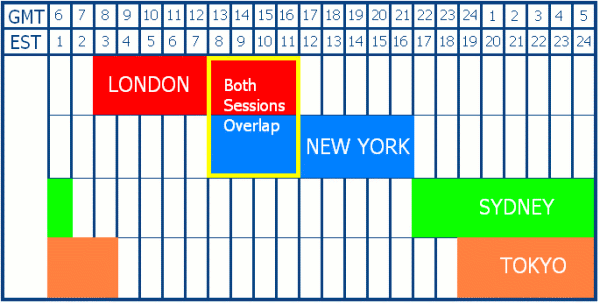There are three main forex moving times that regularly garner
attention, and therefore offer an ability to move prices with momentum:
- They are the 2am EDT German Dax futures market getting underway,
- the
6-7am EDT London gold/oil fixings, and
- LIBOR rates being set, and the 11am EDT European market close.
Outside of that, the return from lunch in Japan between 11pm EDT and
midnight, and the closing of the NYMEX markets at 2.30 pm EDT really are
the only other times that prices move substantially and then hold.
At the end of the U.S. session the pattern is for Asian markets to try and initially reverse U.S. trade direction, although the lack of volume tends to soon allow pairs to find and hold support areas. The European markets tend to move in the same direction as Asian trade, and then Chicago based futures movement will try to reverse things back in the direction of where the U.S. previously closed, and re-set their books as the London fixings are placed between 5-6am EDT.
At 10:30am GMT in London, telephone bids for the gold and oil fixings take place, something that sets the morning clearing prices for bullion and crude dealers that (are then adjust once again at 3.30pm GMT). At 11am GMT each day in London the British Bankers Association set the inter-bank LIBOR rates, something that sets the tone for lending rates between financial market participants.
The London fixings tend to force Chicago based futures markets into a re-alignment program at 06:00 EDT that replicates the newly set fair values on oil, gold, and lending rates, and by default tends to then impact Usd based currency values. It is rare for the U.S. not to push back each morning and reverse the pattern of forex trade that came before, especially if a sizeable move has happened in overnight forex trade.
Forex traders really need to know what is going to trigger the technical set-ups, and therefore be prepared to ride momentum while it lasts, and to cap expectancy and exposure in things are moving against the near-term trend. In the trading forex arena there are different things to look for than in the equity and bond investment world; a week in forex absorb fifteen regional equity market moves, and all of which are movinmg for varying commercial regions, and using foreign exchange to hedge commitments, repatriate overseas profits, align reserve values, and garner swap interest.
The European and NYMEX close (11am EDT and 2.30 pm EDT are the U.S. based things to get out of the way, because then, maybe, the equity markets can reveal where they really want to go, and by default send the Usd in the opposite direction. Traders looking for moves outside of 2am, 6am, 11am, and maybe 2:30 EDT, may just find themselves sitting and waiting, wondering why they just bought the high of the day that then reversed.
Until then it seems that the 24 hour a day S&P futures trade will set up the eight hour S&P cash market for currency traders to monitor, that will be followed by the S&P futures market tracking the 16 hours of Asian and European activity. Forex will follow that equity trend, at least until interest rates start to rise globally, and economic expansion takes place. At that time interest rate differentials will take over the valuation of forex pairs, to the greater degree.


